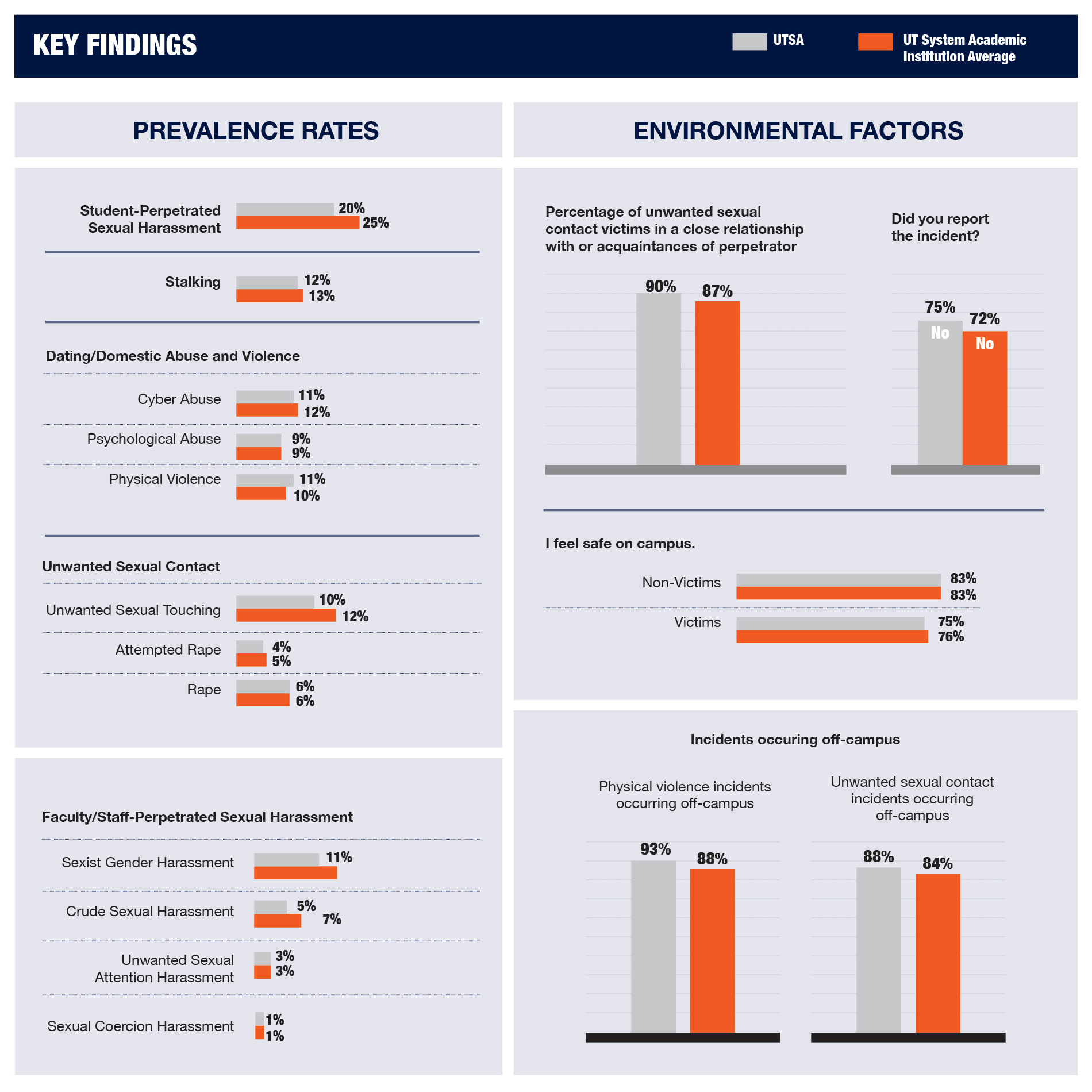Cultivating Learning and Safe Environments
The CLASE report is the most comprehensive survey of sexual assault and misconduct ever undertaken by an institution of higher education. Thirteen of the UT System’s 14 institutions participated in the survey of students’ personal experiences, perceptions and awareness of sexual misconduct. More than 28,000 students from UT System institutions responded to the survey, including 3,385 UTSA students.
Students were asked to self-report their experiences in five key areas and may have responded in more than one category.
Frequently Asked Questions
- Who conducted the CLASE survey?
- When was the survey conducted?
- How was the survey conducted?
- Who participated in the survey?
- What was the survey's response rate?
- How many of the respondents were students from the UTSA Downtown Campus?
- What did the survey measure?
- Did the study have limitations?
- What is Title IX?
- What is the Campus SaVE Act?
The Cultivating Learning and Safe Environments (CLASE) survey was conducted by UT-Austin's Institute on Domestic Violence and Sexual Assault for the University of Texas System.
2. When was the survey conducted?
The survey was conducted at UTSA from November 4, 2015 to December 8, 2015.
3. How was the survey conducted?
The CLASE survey was administrated online using the Qualtrics software.
4. Who participated in the survey?
Participation in the CLASE survey was voluntary and consisted of currently enrolled undergraduate and graduate students 18 years of age or older at the Main and Downtown Campuses.
5. What was the survey's response rate?
Across all UT System institutions, the survey achieved a 26 percent response rate. At UTSA, 24,600 students were invited to participate in the CLASE survey and 3,385 (13.8%) completed the survey.
6. How many of the respondents were students from the UTSA Downtown Campus?
Downtown Campus students comprised 10 percent of UTSA's survey respondents.
7. What did the survey measure?
The CLASE survey assessed the prevalence of several forms of violence and misconduct, including sexual harassment, stalking, dating/domestic abuse and violence, and unwanted sexual contact. Students anonymously answered questions in three broad areas: health and well-being, general perceptions about UTSA's response to acts of misconduct and violence, and whether the students had personal experience with any of these types of behaviors.
8. Did the study have limitations?
There were several study limitations. Voluntary surveys can have the potential to reflect response bias because some participants may have answered survey questions either inaccurately or untruthfully due to a misunderstanding or to be socially desirable. In addition, some say that students with the experience of victimization are more drawn to this type of study.
9. What is Title IX?
Title IX is a landmark federal civil right of the Education Amendment of 1972 that states, "No person in the United States shall, on the basis of sex, be excluded from participation in, be denied the benefits of, or be subjected to discrimination under any education program or activity receiving Federal financial assistance." (U.S. Department of Education, 2015)
Prohibited types of sex discrimination under Title IX include sexual harassment, stalking, dating/domestic abuse and violence, and sexual assault. Learn more about Title IX at www.utsa.edu/eos/titleix.html and www.utsa.edu/eos/faqtitleix.html#harass1.
10. What is the Campus SaVE Act?
The Campus SaVE Act amended the Clery Act to mandate extensive "primary prevention and awareness programs" regarding sexual misconduct and related offenses.
